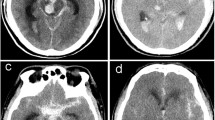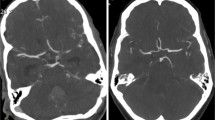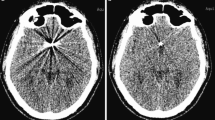Abstract
Introduction
Endovascular coiling of intracranial aneurysms carries a risk of complications. Early detection and management of complications can improve clinical outcomes. AngioCT is a new imaging technology enabling CT-like images to be generated on a flat-panel digital subtraction angiography system, which can provide immediate “on angio table” identification and thorough assessment of such complications. We prospectively audited its utility during aneurysm coiling in patients following subarachnoid haemorrhage (SAH).
Methods
A prospective series of 44 patients with SAH undergoing endovascular coiling with AngioCT was audited for image quality and the influence of the AngioCT on patient management. In a parallel experimental study, radiation doses were measured and image quality parameters on standard phantoms were established.
Results
In all patients, AngioCT provided adequate diagnostic information. In 40.9% of patients, AngioCT was a substantial or major factor in determining the management immediately after coiling. Using a 10-s high-dose acquisition technique, acceptable image quality could be obtained rapidly with a radiation dose just over half that for a conventional CT scan of the head (35 mGy versus approximately 60 mGy). No patient in this series required conventional CT to clarify the AngioCT appearance.
Conclusion
AngioCT has many applications in the neurointerventional setting. In particular during coiling, AngioCT provides a rapid way to clarify concerns or identify complications and in some cases was the major factor influencing further patient management immediately after coiling. AngioCT images were judged of adequate quality to be clinically useful in all patients in this series.



Similar content being viewed by others
References
Molyneux AJ, Kerr RS, Yu LM et al (2005) International subarachnoid aneurysm trial (ISAT) of neurosurgical clipping versus endovascular coiling in 2143 patients with ruptured intracranial aneurysms: a randomised comparison of effects on survival, dependency, seizures, rebleeding, subgroups, and aneurysm occlusion. Lancet 366:809–817
van Rooij WJ, Sluzewski M, Beute GN et al (2006) Procedural complications of coiling of ruptured intracranial aneurysms: incidence and risk factors in a consecutive series of 681 patients. AJNR Am J Neuroradiol 27(7):1498–1501
Brisman JL, Niimi Y, Song JK et al (2005) Aneurysmal rupture during coiling: low incidence and good outcomes at a single large volume center. Neurosurgery 57(6):1103–1109
Horowitz MB, Crammond D, Balzer J et al (2003) Aneurysm rupture during endovascular coiling: effects on cerebral transit time and neurophysiologic monitoring and the benefits of early ventriculostomy: case report. Minim Invasive Neurosurg 46(5):300–305
Cloft HJ, Kallmes DF (2002) Cerebral aneurysm perforations complicating therapy with Guglielmi detachable coils: a meta-analysis. AJNR Am J Neuroradiol 23(10):1706–1709
Levy E, Koebbe CJ, Horowitz MB et al (2001) Rupture of intracranial aneurysms during endovascular coiling: management and outcomes. Neurosurgery 49(4):807–811
Heran NS, Song JK, Namba K et al (2006) The utility of DynaCT in neuroendovascular procedures. AJNR Am J Neuroradiol 27(2):330–332
Benndorf G, Strother CM, Claus B et al (2005) Angiographic CT in cerebrovascular stenting. AJNR Am J Neuroradiol 26:1813–1818
Fineberg HV, Bauman R, Sosman M (1977) Computerized cranial tomography. Effect on diagnostic and therapeutic plans. JAMA 238(3):224–227
Shrimpton PC (2004) Assessment of patient doses in CT. NRPB-PE/1/2004. Health Protection Agency, Chilton. Also published as Appendix C of the 2004 CT Quality Criteria (MSCT, 2004) at http://www.msct.info/CT_Quality_Criteria.htm
Hart D, Jones DG, Wall BF (1994) Estimation of effective dose in diagnostic radiology from entrance surface dose and dose-area product measurements. NRPB-R262. Health Protection Agency, Chilton
Edyvean S, Lewis MA, Keat N et al (2003) Measurement of the performance characteristics of diagnostic imaging systems in medicine, Part III - Computed tomography X-ray scanners (report no. 32). Institute of Physics and Engineering in Medicine, York, UK
Shrimpton PC, Hillier MC, Lewis MA et al (2006) National survey of doses from CT in the UK: 2003. Br J Radiol 79:968–980
Fry K (1984) Who needs high technology? Br J Radiol 57:765–772
Dixon AK (1997) Evidence-based diagnostic radiology. Lancet 350:509–512
Conflict of interest statement
We declare that we have no conflict of interest.
Author information
Authors and Affiliations
Corresponding author
Rights and permissions
About this article
Cite this article
White, P.M., Gilmour, J.N., Weir, N.W. et al. AngioCT in the management of neurointerventional patients: a prospective, consecutive series with associated dosimetry and resolution data. Neuroradiology 50, 321–330 (2008). https://doi.org/10.1007/s00234-007-0339-5
Received:
Accepted:
Published:
Issue Date:
DOI: https://doi.org/10.1007/s00234-007-0339-5




